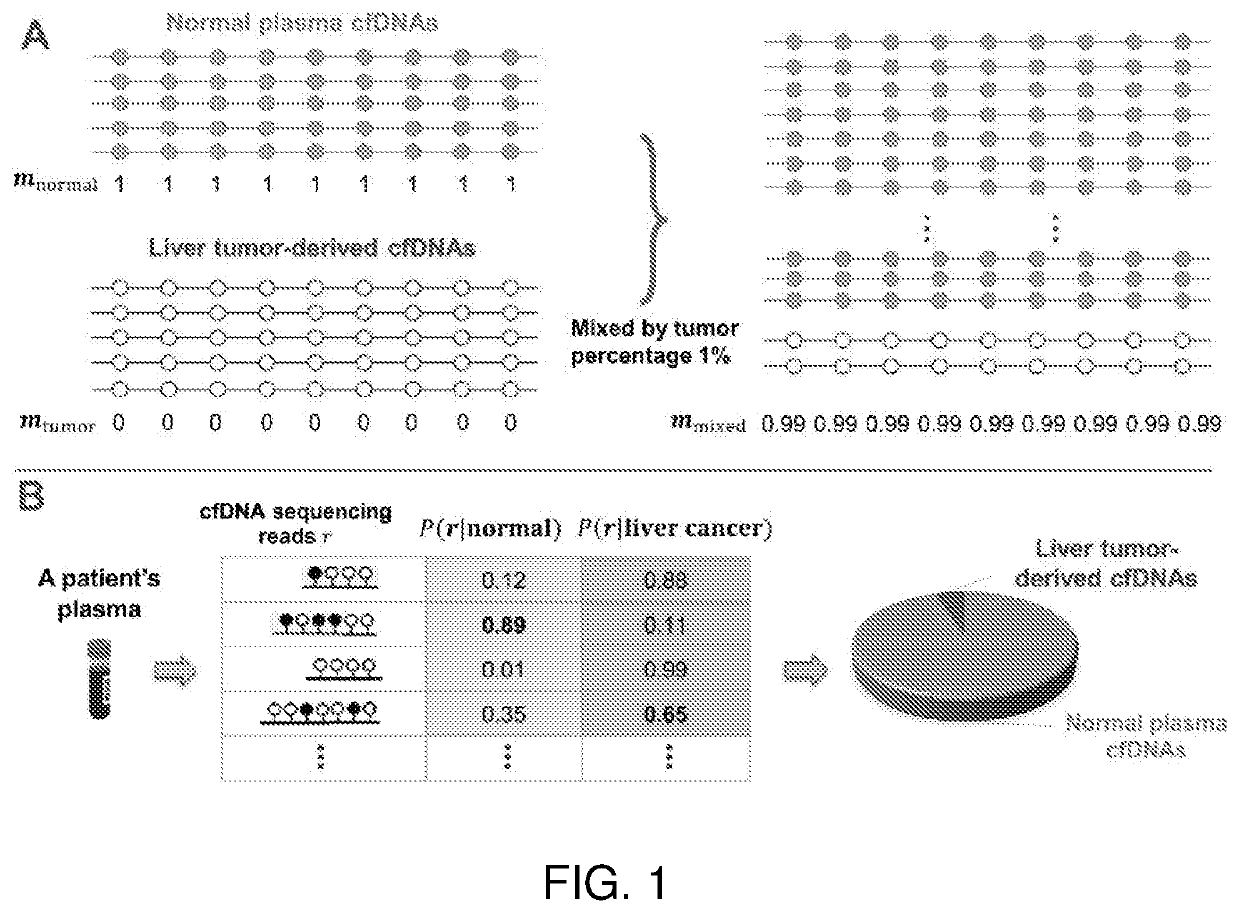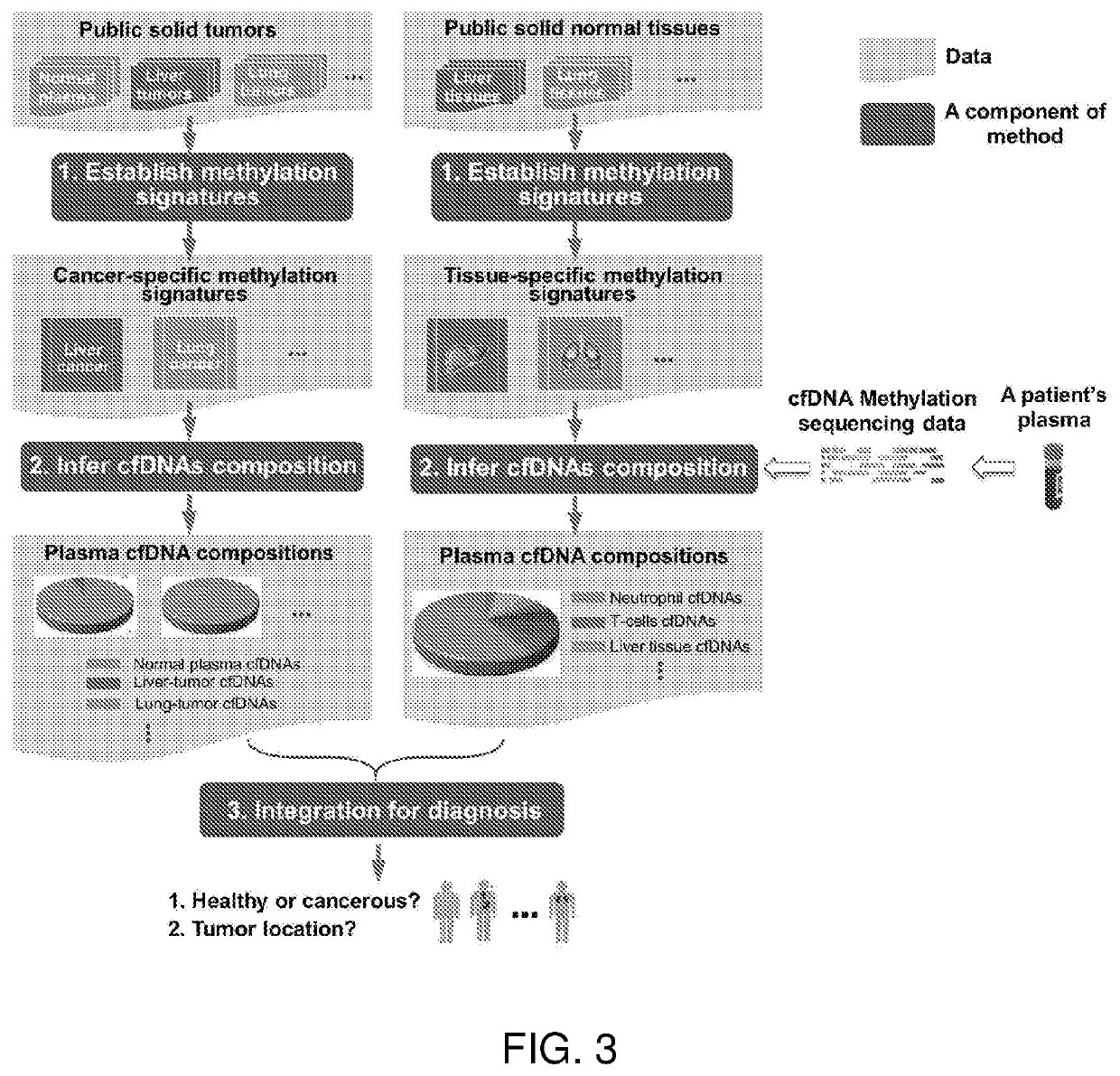Cell-free DNA methylation patterns for disease and condition analysis
a cell-free dna and condition analysis technology, applied in the field of cell-free dna methylation patterns for disease and condition analysis, can solve the problems of low tumor cfdna levels in most early-stage and many advanced tumors, no method or apparatus to provide accurate screening and identification, and often drowned out sequence information representing diseased dna. achieve the effect of low sequencing coverage and accurate results
- Summary
- Abstract
- Description
- Claims
- Application Information
AI Technical Summary
Benefits of technology
Problems solved by technology
Method used
Image
Examples
example 1
Methylation Signatures
[0204]Since most public methylation data of GEO and TCGA are microarray data, a type of summary data which can be best modeled at bin level. Therefore, in this work, bin-level methylation data are used, i.e., Model 1 of FIG. 4, to characterize the methylation signature of each “cancer-specific” or “tissue-specific” region.
[0205]It is noted that the method is flexible to allow two different levels of methylation data to be used in the method.
example 2
Probabilistic Framework of Inferring Plasma cfDNA Compositions with “Phased” Methylation Data
[0206]The second step is to infer plasma cfDNA compositions of T≥2 classes. As shown in FIG. 3, for “cancer composition”, T=2 classes refer to normal plasma cfDNAs and a specific tumor type; while for “tissue composition”, T>2 classes refer to T normal tissue types.
[0207]Due to the small abundance of cfDNA in plasma and utilize the advantages of “phased” data, as shown in FIG. 2, we always perform the methylation sequencing on the patient's plasma cfDNAs. As a result, we have a collection of N cfDNA sequencing reads, covering M CpG sites in all methylation signatures identified in Component 1 of the method. As shown in FIG. 5, these methylation data of fragments can be represented by a ternary matrix R=(rij)×M, where each row (or column) corresponds to a fragment (or CpG site) and each entry rij∈{0,1,−}. rij=0 (or 1) indicates the j-th CpG site is covered by the i-th fragment and is unmethyl...
example 3
Sample Collection and Analysis
[0226]Collecting DNA Methylation Data from Public Tumor Tissue Samples for Characterizing Methylation Signatures:
[0227]We collect all the publically available methylation data of both solid tumors and plasma cfDNA samples of normal people and cancer patients. Since the majority of tumor methylation profiles of the TCGA (The Cancer Genome Atlas) database are assayed by Infinium HumanMethylation450 microarray, we collect only methylation microarray data for solid tumors, covering 2 tissue types: liver (LIHC) and lung (cancer types include LUAD and LUSC). As of December 2013, we collected 169 LIHC tumors, and 450 / 359 LUAD / LUSC tumors. Note that we used only normal tissue samples from RoadMap project. In future, we will use the microarray methylation data of solid normal tissue samples from GEO and TCGA.
[0228]Here, LIHC stands for Liver Hepatocellular Carcinoma; LUAD stands for Lung Adenocarcinoma; and LUSC stands for Lung Squamous Cell Carcinoma.
[0229]Buil...
PUM
| Property | Measurement | Unit |
|---|---|---|
| biological composition | aaaaa | aaaaa |
| composition | aaaaa | aaaaa |
| time | aaaaa | aaaaa |
Abstract
Description
Claims
Application Information
 Login to View More
Login to View More - R&D
- Intellectual Property
- Life Sciences
- Materials
- Tech Scout
- Unparalleled Data Quality
- Higher Quality Content
- 60% Fewer Hallucinations
Browse by: Latest US Patents, China's latest patents, Technical Efficacy Thesaurus, Application Domain, Technology Topic, Popular Technical Reports.
© 2025 PatSnap. All rights reserved.Legal|Privacy policy|Modern Slavery Act Transparency Statement|Sitemap|About US| Contact US: help@patsnap.com



